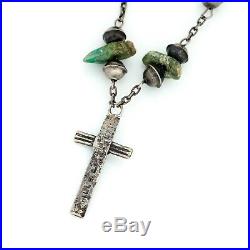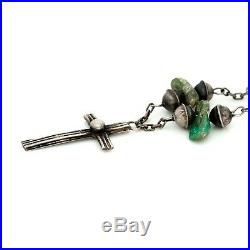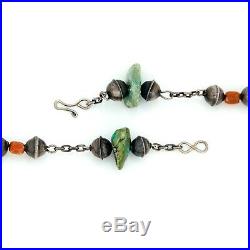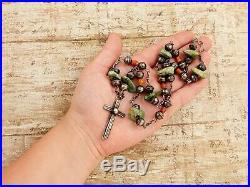






We have similar Native and Pueblo items, which would pair nicely with this piece, for sale this week. Listing Description by: Dylan L. Age Circa: Antique Native Pueblo C. Markings: Marked “HILL S STERLING” on the back of the pendant, Tested, and Guaranteed. Country of Origin: United States, Pueblo Nation. Brand: Unidentified HILL Makers Mark. Gram Weight: 36.6 Grams. Main Stone: Ajax Turquoise. Main Stone Measurements/Color: The size of the turquoise in this necklace varies, On average each stone measures 19.9 mm long by 15.6 mm wide, Opaque blue-green hue with beige striations. Accent Stone: Red Coral. Accent Stone Measurements/Color: The size of the red coral varies, On average it measures 4.7 mm long by 6.4 mm wide, Opaque deep red hue. Stone Treatment: The stone(s) appear to be untreated, but we are not certified gemologists. Stone(s) have been tested and guaranteed using a professional Presidium Duo refractive, heat, and hardness tester. Stone Cuts: Tumbled Smooth Turquoise, Hand Carved and Polished Red Coral. Item Measurements: The necklace has a wearable length of 24.75″ measures 0.74″ wide at its widest. The bench beads measure 0.35″ long by 0.29″ wide. The pendant measures 1.73″ long by 0.95″ wide. Closure/Clasp Type: Hook Clasp, Standard Bale. 925 Sterling Silver Links With Turquoise and Coral. Pendant Type: Drop/Dangle Pendant. Notable Features: The necklace was handmade during the Fred Harvey era circa 1940 by a talented Santo Domingo Pueblo artisan. This gorgeous necklace was made in the style of a rosary, and features a large hand hammered cross, as well as a multitude of turquoise and red coral stones. This lovely item would have been carefully crafted by hand, with extreme detail being given to every portion of the item. This necklace is certain to stun, and is a lovely example of the great talent of the Santo Domingo Puebloan people. This gorgeous item features tumbled ajax turquoise stones as well as hand carved and polished red coral beads. The gorgeous ajax turquoise stones are a stunning opaque blue-green hue, with shades of both throughout as well as beige striations. The many hues displayed within these rare turquoise stones highlights the natural appearance of the item, and contributes to the overall eye-catching effect of the piece. The red coral in this item was hand carved and polished into cabochon cut cylindrical beads. Red coral was a way in which one could denote wealth in many Native American tribes, which adds a glamorous aspect to this lovely item. To either side of each turquoise or red coral stone is a bench bead, which would have been made entirely by hand using the repousse technique. The repousse technique dates back as far as the 3rd century BC and involves hand hammering precious metals into beautiful and intricate patterns. This lovely item features large chain links, which connect each portion of the necklace to the other. The cross adorning the necklace features long, repeating linear motifs as well as a large applied sphere in the middle of the pendant, which is certain to catch one’s attention. This gorgeous Santo Domingo Pueblo necklace is an incredible find, and is extremely valuable. This lovely Puebloan necklace would make a gorgeous addition to any antique collection and is not soon to be forgotten. Please don’t miss your opportunity to own this amazing piece of world history. Damage: Age appropriate wear. There is some natural wear to the stones, which likely occured while the item was being made, and is to be expected of an item this age. The sterling silver is tarnished, which adds a lovely antique appearance to the item, and draws out the hues of the stones adorning the necklace. The price of this item has been reduced to reflect this. This listing is for the item only. This beautiful piece was made by a very talented Native American silversmith. It features handcrafted silversmith work throughout. Antique Native American jewelry is very rare to find. This is due to these pieces being made for reservation and personal use before the tourist trade became popular. Very few pieces were made and even less survived to today. Kewa Pueblo, formerly known as Santo Domingo Pueblo, is located on the Rio Grande and is particularly known for Native Pueblo artists who create heishi necklaces made of bone, shell and turquoise beads, some of which are so finely cut that they almost look like strands of hair. These beautiful and colorful necklaces are also sometimes incorrectly identified as “Depression Jewelry”, however, their origin certainly predates the Great Depression, and they are still being made today by Kewa artists. Pueblo artisans are also quite famous for their inlaid mosaic-like pieces. The concept of Pawn, Old Pawn, and Dead Pawn Native American Jewelry came to be in the 1800s. When a loan wasnt repaid, the item became known as either Old Pawn or Dead Pawn. Turquoise is found all over the world and has been a popular semi-precious stone used in jewelry and art for thousands of years by many different cultures; from prehistoric times to the present. Turquoise comes in many beautiful color variations; from the popular bright solid sky-blue hues to dark blue hues with dark spiderwebbing throughout, as well as aqua, teal, and many green varieties, and even some rare white with dark spiderwebbing. Ajax Turquoise is mined exclusively in Nevada and is one of the only naturally green turquoise stones in the world. The stones range in color from light blue with darker blue veining, to the most rare and desirable deep green with light blue veining and mottling. Not all Ajax stones display a matrix, but the ones that do are truly breathtaking. Ajax is an American turquoise most commonly found in old pawn Native American jewelry. Red Coral is a highly prized stone by Native American cultures and has long been used by artisans in the Southwest. Spanish traders introduced coral to the Navajo, Zuni, Hopi, and other tribes, and it quickly became a sign and symbol of wealth and status in many different Native American cultures. It varies in color from deep red to orange, with red being the preferred choice of Native American jewelry makers. Repoussé began as an ancient metalworking technique dating as far back as the 3rd century BC, involving malleable metal that was hammered onto the reverse side to create an image on the front. Examples are found all over the world; Greece, Egypt, and even the Hopewell periods in the American southeast. Reverse side hammering was also used to add detail to the front, creating intricate patterns using grooves, indentations, and channeling. The piece was then carefully polished to create a hollow, eye-catching treasure. The item “Antique Vintage Sterling Silver Native Pueblo Santo Domingo HILL Rosary Necklace” is in sale since Sunday, August 11, 2019. This item is in the category “Jewelry & Watches\Ethnic, Regional & Tribal\Native American\Necklaces & Pendants”. The seller is “abeautifultimeco” and is located in Fort Collins, Colorado. This item can be shipped worldwide.
- Country of Origin: United States, Santo Domingo
- Modified Item: No
- Country/Region of Manufacture: United States
- Ethnic Origin: Pueblo
- Type: Beads
- Featured Refinements: Santo Domingo Necklace
- Stone #2: Coral
- Metal Purity: .925
- Artisan: Hill
- Main Stone: Turquoise
- Metal: Sterling Silver
- Brand: Hill
- Jewelry Type: Necklaces
- Tribal Affiliation: Santo Domingo
